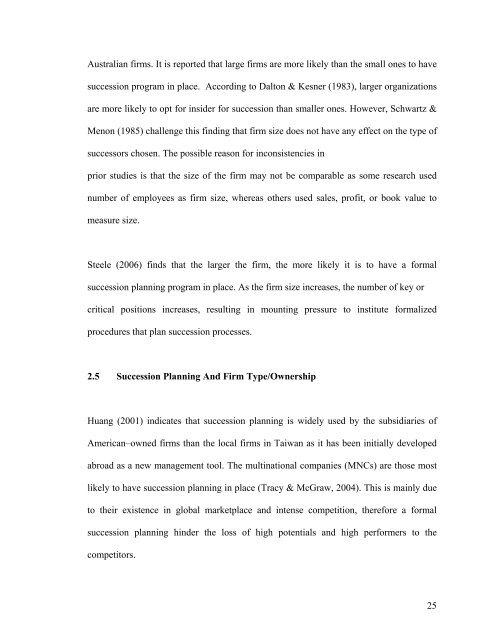CHAPTER 1: INTRODUCTION 1.0 Chapter Overview - DSpace@UM
CHAPTER 1: INTRODUCTION 1.0 Chapter Overview - DSpace@UM
CHAPTER 1: INTRODUCTION 1.0 Chapter Overview - DSpace@UM
You also want an ePaper? Increase the reach of your titles
YUMPU automatically turns print PDFs into web optimized ePapers that Google loves.
Australian firms. It is reported that large firms are more likely than the small ones to havesuccession program in place. According to Dalton & Kesner (1983), larger organizationsare more likely to opt for insider for succession than smaller ones. However, Schwartz &Menon (1985) challenge this finding that firm size does not have any effect on the type ofsuccessors chosen. The possible reason for inconsistencies inprior studies is that the size of the firm may not be comparable as some research usednumber of employees as firm size, whereas others used sales, profit, or book value tomeasure size.Steele (2006) finds that the larger the firm, the more likely it is to have a formalsuccession planning program in place. As the firm size increases, the number of key orcritical positions increases, resulting in mounting pressure to institute formalizedprocedures that plan succession processes.2.5 Succession Planning And Firm Type/OwnershipHuang (2001) indicates that succession planning is widely used by the subsidiaries ofAmerican–owned firms than the local firms in Taiwan as it has been initially developedabroad as a new management tool. The multinational companies (MNCs) are those mostlikely to have succession planning in place (Tracy & McGraw, 2004). This is mainly dueto their existence in global marketplace and intense competition, therefore a formalsuccession planning hinder the loss of high potentials and high performers to thecompetitors.25
















